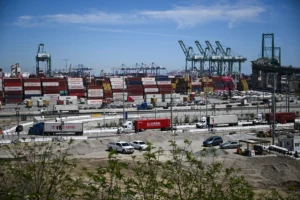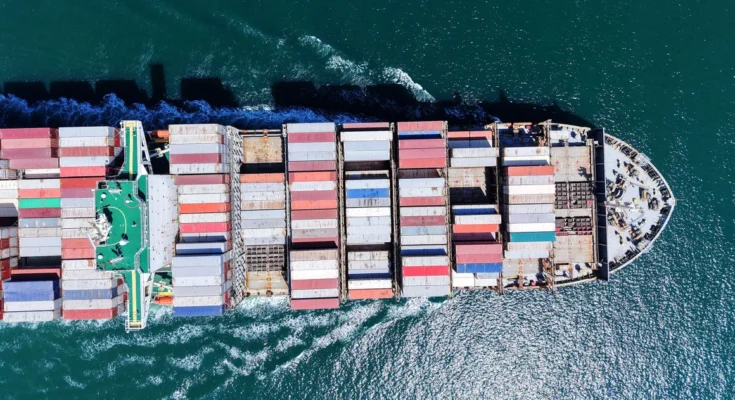**The Arrival of Cargo from China and the Impending Shortages**
Cargo shipments from China that were loaded after April 9 will incur a substantial 145% tariff imposed by President Donald Trump last month. While these shipments are set to arrive next week, there will be a noticeable reduction in the number of vessels at sea, coupled with a decrease in cargo volume. For many importers, the cost of doing business with China has become prohibitively high.
Despite this, China remains one of the United States’ key trading partners, supplying a significant proportion of clothing, footwear, electronics, and microchips that power various appliances and devices.
Businesses now face a tough dilemma: either continue to sell Chinese products at prices that have more than doubled or cease selling them entirely. For consumers, this scenario translates into potential shortages of certain goods or prices that are simply unaffordable.
“Next week marks the beginning of the influx related to the tariff announcement on April 2,” stated Gene Seroka, executive director of the Port of Los Angeles, which relies heavily on Chinese imports. “Cargo volumes arriving in Los Angeles are expected to decline by 35% compared to last year.”
Looking ahead, imports into the United States for the latter half of 2025 are projected to decrease by at least 20% year-on-year, as reported by the National Retail Federation. The decline in imports from China is anticipated to be even more severe, with JP Morgan forecasting a staggering 75% to 80% drop. Such a drastic reduction could lead to sharp price increases and significant disruptions in supply chains if alternative sources of imports do not fill the gap.
This situation indicates fewer job opportunities, higher prices in stores, and a narrower selection of products for consumers. Seroka warns that the countdown to these impacts has already started.
“Many major retailers have indicated they currently have a six- to eight-week inventory supply,” Seroka remarked. “Manufacturers and consumers in the U.S. will face tough choices in the coming weeks and months if policies do not change.”
**Idle Ships and Empty Ports**
At the Port of Shanghai, China’s largest cargo port, many large cargo ships are currently inactive. Shipping companies are opting for smaller vessels to transport goods as demand dwindles. In April, sailings from China to the U.S. dropped by 60%, according to logistics broker Flexport.
“The shipping companies have canceled numerous sailings, stating they won’t operate ships that are only half full,” explained Ryan Peterson, CEO of Flexport. “Numerous ships are idling off the coast of China, anticipating a resolution.”
In March, the Port of New York and New Jersey emerged as the busiest port in the U.S. as retailers preemptively loaded cargo before the tariffs took effect. However, the port anticipates a significant decrease in volume this month.
A quarter of the cargo entering the East Coast port comes from China, but there has been an increase in imports from Vietnam, Malaysia, and Southeast Asia as retailers attempt to circumvent Chinese tariffs.
**Impending Price Increases**

Once these goods reach U.S. ports, they typically take just a few weeks to appear on store shelves. As current inventories deplete, consumers will encounter higher-priced tariffed goods.
“There’s significant concern right now. Retailers are strategizing about their back-to-school and holiday inventory orders and determining how and when to place them,” remarked Jonathan Gold, vice president of supply chain and customs policy at the National Retail Federation.
While larger retailers can stockpile inventory, smaller businesses lack this ability.
“Small retailers, especially those who cannot absorb the tariff impact, are trying to navigate their next steps,” Gold added.
Americans depend on China for countless products, ranging from flat-screen TVs to baby strollers. The United States imports more toys, clothing, and footwear from China than from any other country, according to the United States International Trade Commission. A recent Gartner survey revealed that 45% of supply chain leaders anticipate passing tariff-induced costs onto consumers.
Seroka predicts that while shelves may not be empty, the variety of available products will be limited. “If you’re looking for a specific type of pants, you might find various options, but not the one you want, and the ones available will be priced higher,” he stated.
In contrast, Peterson from Flexport expresses greater concern. “If this situation persists for several more weeks, retailers will exhaust their current inventory, leading to shortages and empty shelves by summer.”
**Economic Consequences of Reduced Cargo**

As the influx of cargo ships diminishes at U.S. ports, local economies will feel the immediate effects, according to Seroka. Business from China constitutes 45% of the Port of Los Angeles’s operations—the highest share of any U.S. port. A drop in this volume will create less demand for labor.
“I don’t foresee mass layoffs at the port, but truckers who currently transport four or five containers may only be hauling two or three after next week,” Seroka observed. “Similarly, dock workers who have been receiving overtime may find themselves working fewer hours due to the reduced container arrivals, and the same goes for warehousing staff.”
The American Trucking Associations recently urged President Trump to negotiate agreements with key trading partners, including Canada, Mexico, and China, to safeguard trucking jobs.
“The longer tariffs remain in place, the greater the impact on truckers, as well as the families and businesses we serve,” stated Chris Spear, president and CEO of American Trucking Associations last month. “Not only will tariffs diminish cross-border freight, but they will also escalate operational costs. The expense of a new truck could increase by up to $35,000, amounting to a $2 billion annual tax that would make new equipment unaffordable for small carriers.”
Since the supply chain crisis triggered by the pandemic, retailers have sought to relocate production from China to Vietnam and other Asian countries with manufacturing capabilities. However, Gold emphasizes that imports from these alternative countries are insufficient to offset the decline in Chinese cargo.
“Building new supplier relationships takes time—months or even years—to ensure that they have the necessary capacity, skilled workforce, and infrastructure, as well as to fulfill all testing requirements for products entering the U.S., particularly for children’s items,” Gold explained. “This transition is not something that can happen overnight.”
—



